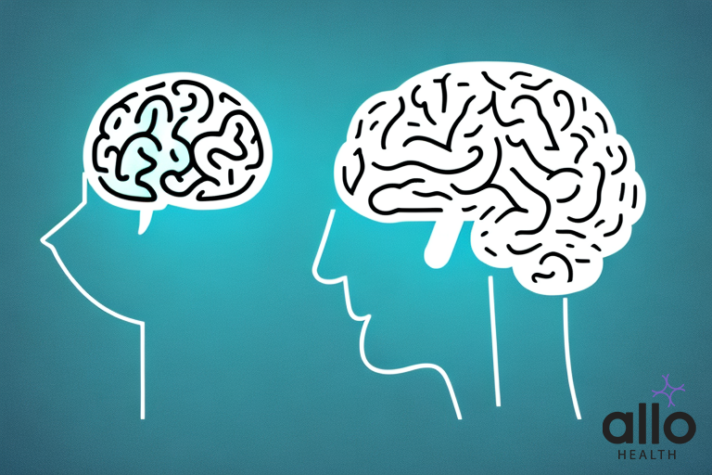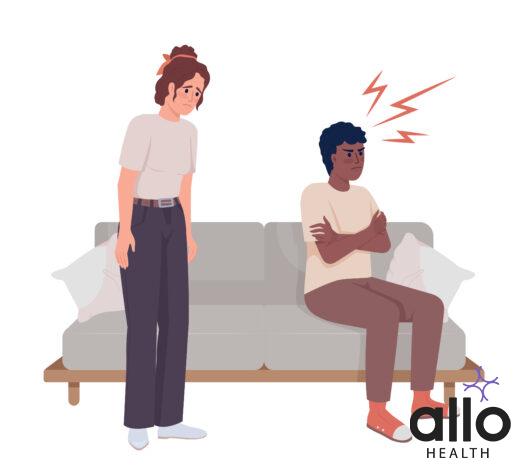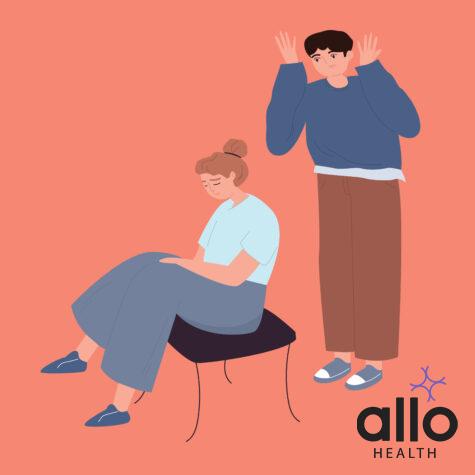Understanding the Dynamics of Abusive Relationships

Allo Health is dedicated to personalized well-being, offering support and trusted information tailored to individual health goals. The platform emphasizes human-generated content, led by a distinguished medical team of experts, including physicians and sexual health specialists. Their commitment to credibility involves rigorous fact-checking, authoritative research, and continuous updates to ensure accurate, up-to-date information. Allo Health's unique approach goes beyond conventional platforms, providing expert-led insights and a continuous commitment to excellence, with user feedback playing a crucial role in shaping the platform's authoritative voice.

A psychologist with clinical specialization and experience working with sub-clinical and clinical populations. Her areas of interest and expertise include anxiety-related disorders, mood disorders, psychotic disorders, addictions, sexual health and wellness, relationship issues, stress, and geriatric mental health.
Why This Was Upated?
Our experts continually monitor the health and wellness space, and we update our articles when new information became available.
Updated on 26 December, 2023
- Article was updated as part of our commitment to diversity, equity, and inclusion.

"The following blog article provides general information and insights on various topics. However, it is important to note that the information presented is not intended as professional advice in any specific field or area. The content of this blog is for general educational and informational purposes only.
Book consultation
The content should not be interpreted as endorsement, recommendation, or guarantee of any product, service, or information mentioned. Readers are solely responsible for the decisions and actions they take based on the information provided in this blog. It is essential to exercise individual judgment, critical thinking, and personal responsibility when applying or implementing any information or suggestions discussed in the blog."
Abusive relationships are unfortunately quite common in today’s society. They can take many forms, from physical violence to emotional manipulation.
Types of Abuse in Relationships: Physical, Emotional, and Sexual
Abuse in relationships can take various forms and can occur in any type of relationship, including romantic partnerships, marriages, friendships, family relationships, and professional relationships. Here are some of the most common types of abuse in relationships:
- Physical Abuse: Physical abuse involves the use of physical force against an individual, resulting in harm or injury. It may include hitting, slapping, punching, kicking, choking, or any other form of physical violence.
- Emotional or Psychological Abuse: Emotional abuse involves behaviors that manipulate, belittle, or undermine the emotional well-being and self-esteem of the victim. Examples include constant criticism, humiliation, intimidation, gaslighting (making someone doubt their own sanity or perception of reality), and controlling behavior.
- Verbal Abuse: Verbal abuse refers to the use of words and language to demean, insult, or humiliate a person. This can include yelling, shouting, name-calling, mocking, or using derogatory language towards the victim.
- Sexual Abuse: Sexual abuse involves any non-consensual sexual activity or behavior that is forced upon the victim. It can include rape, sexual assault, unwanted sexual advances, coercion, or any form of sexual exploitation.
- Financial Abuse: Financial abuse occurs when one partner exerts control over the other’s finances, limiting their access to money or financial resources. This can involve preventing the victim from working, controlling their income, or misusing their financial resources without their consent.
- Digital or Online Abuse: With the rise of technology, digital abuse has become more prevalent. It involves the use of technology to control, harass, or intimidate the victim. This can include monitoring their online activities, stalking them on social media, sending threatening messages, or spreading private information without consent.
- Isolation: Isolation occurs when one partner deliberately isolates the victim from their support system, such as family, friends, or social activities. The abuser may control the victim’s social interactions, restrict their movements, or discourage them from maintaining relationships outside the abusive relationship.
- Spiritual or Religious Abuse: This type of abuse involves using religious or spiritual beliefs to manipulate or control the victim. It can include forced religious practices, using religious texts to justify abusive behavior, or preventing the victim from practicing their own beliefs.
Abuse is never acceptable, and no one deserves to be mistreated.
If you or someone you know is experiencing any form of abuse in a relationship, it is crucial to seek help and support from trusted individuals, helplines, or organizations specializing in domestic violence or abuse.
Warning Signs of Abusive Relationships You Should Look Out For
Recognizing the warning signs of an abusive relationship is crucial in order to protect oneself or others from harm. Abusive relationships can be difficult to identify at first, as they often involve a gradual escalation of controlling and manipulative behaviors. Here are some warning signs to look out for:
- Excessive Jealousy and Possessiveness: An abusive partner may display extreme jealousy and possessiveness, constantly questioning your activities, accusing you of infidelity without evidence, or isolating you from friends and family. They may want to know where you are at all times and monitor your communication.
- Controlling Behavior: Abusers often exert control over their partners by making decisions on their behalf, dictating what they can wear, whom they can socialize with, and where they can go. They may use manipulation, threats, or guilt to ensure compliance.
- Emotional Manipulation: Abusers may manipulate their partners’ emotions to maintain control. They might use guilt, blame, or gaslighting techniques to make the victim doubt their own feelings, perceptions, or sanity. They may also engage in frequent emotional outbursts or mood swings.
- Verbal Abuse: Verbal abuse involves using words to degrade, insult, or humiliate the victim. Warning signs include constant criticism, name-calling, yelling, swearing, or mocking. The abuser may try to diminish the victim’s self-worth and undermine their confidence.
- Physical Violence: Physical abuse is a clear warning sign of an abusive relationship. This includes any form of physical harm such as hitting, slapping, pushing, kicking, choking, or using weapons. Even a single incident of physical violence is a serious red flag.
- Sexual Coercion or Assault: An abuser may engage in non-consensual sexual activity or coerce their partner into unwanted sexual acts. They may disregard their partner’s boundaries, use manipulation or force, or refuse to accept “no” for an answer.
- Isolation: Abusers often isolate their partners from friends, family, and support networks. They may discourage or prevent you from spending time with loved ones, controlling your access to social activities or resources, and making you dependent on them for all emotional and practical needs.
- Drastic Mood Swings and Explosive Anger: Abusers may have unpredictable and intense mood swings, going from loving and apologetic to angry and aggressive. They may have difficulty managing their anger and may resort to violent or threatening behavior.
- Financial Control: Abusers may control the victim’s finances, limiting their access to money, monitoring their spending, or forcing them to account for every penny spent. This can create a sense of dependence and make it difficult for the victim to leave the relationship.
- Threats and Intimidation: Abusers often use threats to maintain control and instill fear in their partner. They may threaten physical harm, harm to loved ones, or even suicide if the victim attempts to leave or seek help.
If you recognize any of these warning signs in your relationship or in someone you know, it is important to take them seriously. Reach out to a trusted friend, family member, or a helpline specializing in domestic violence to discuss your concerns and explore available resources and options for support and safety planning.
How Power and Control Play a Role in Abusive Relationships
Power and control dynamics are at the core of abusive relationships. Abusers seek to establish and maintain power and control over their partners through various manipulative tactics. Here is a detailed explanation of how power and control play a role in abusive relationships:
- Power Imbalance: Abusive relationships often involve an imbalance of power, where the abuser seeks to exert control and dominance over their partner. This power imbalance can stem from societal factors, such as gender, or personal factors, such as personality traits or insecurities.
- Controlling Behavior: Abusers use controlling behavior as a means to maintain power. They may control various aspects of their partner’s life, including their social interactions, finances, daily activities, and decision-making processes. By exerting control, they limit the victim’s autonomy and independence.
- Manipulation and Gaslighting: Abusers frequently employ manipulative tactics to distort their partner’s perception of reality. Gaslighting is a common form of manipulation where the abuser makes the victim doubt their own feelings, thoughts, and experiences. They may deny or minimize abusive behaviors, shift blame onto the victim, or distort the truth to maintain control.
- Emotional and Psychological Abuse: Emotional abuse targets the victim’s emotions, self-esteem, and mental well-being. Abusers may engage in constant criticism, humiliation, name-calling, or demeaning behaviors. They may use emotional manipulation to induce fear, guilt, or shame in their partner, making them more vulnerable and easier to control.
- Isolation: Isolation is a tactic used by abusers to cut off their partner from external support systems. They may discourage or prevent the victim from maintaining relationships with family, friends, or colleagues. By isolating the victim, the abuser increases their power and control, as the victim becomes more dependent on them for emotional and practical needs.
- Threats and Intimidation: Abusers often use threats and intimidation to instill fear in their partner. These threats can be physical, emotional, or psychological in nature. By creating an atmosphere of fear and unpredictability, the abuser maintains control and prevents the victim from resisting or leaving the relationship.
- Economic Control: Abusers may exert control over their partner’s finances, restricting their access to money, monitoring their spending, or forcing them to account for every penny. This financial control can make it difficult for the victim to leave the relationship, as they may lack the financial resources or independence to do so.
- Physical Violence: Physical violence is an extreme manifestation of power and control in abusive relationships. It serves as a way for the abuser to exert dominance, instill fear, and maintain control over their partner’s actions. Physical violence can range from hitting, slapping, or pushing to more severe forms of abuse, such as choking or using weapons.
Power and control dynamics are not present in healthy relationships, where mutual respect, equality, and open communication prevail. Recognizing these dynamics in an abusive relationship is crucial for understanding the need for intervention and seeking help. If you or someone you know is in an abusive relationship, it is important to reach out to a helpline or support organization specializing in domestic violence for assistance.
The Cycle of Violence: Why Abusive Relationships Are Hard to Escape
The cycle of violence refers to the recurring pattern that often characterizes abusive relationships. This cycle typically consists of three phases: the tension-building phase, the explosion or acute battering phase, and the honeymoon or reconciliation phase. Understanding this cycle helps explain why abusive relationships can be challenging to escape. Here’s a detailed breakdown of each phase:
- Tension-Building Phase: In this initial phase, tension and conflict gradually escalate within the relationship. The abuser may become increasingly irritable, controlling, or critical. The victim often tries to diffuse the tension by complying with the abuser’s demands, walking on eggshells, or attempting to keep the peace. The victim may also internalize the blame for the abuser’s behavior, hoping to prevent further escalation.
- Explosion or Acute Battering Phase: This phase is characterized by an outburst of abusive behavior. The tension that has been building reaches a peak, leading to an explosion of violence or abuse. The abuser may physically, emotionally, or sexually harm the victim. The victim experiences fear, pain, and trauma during this phase. The abuse is often followed by a sense of shock, confusion, and devastation.
- Honeymoon or Reconciliation Phase: After the acute battering phase, the abuser may express remorse, apologize profusely, and promise that the abuse will never happen again. This phase is often characterized by the abuser showing affection, kindness, and making efforts to “make up” for their behavior. They may shower the victim with gifts, compliments, or gestures of love. The victim, longing for the relationship to return to the earlier, more positive stages, may believe that the abuser will change and that the abuse was an isolated incident.
However, over time, the honeymoon phase diminishes, and the tension begins to build again, restarting the cycle. As the cycle repeats, it becomes increasingly difficult for the victim to break free from the relationship due to various factors:
- Emotional Bond: The victim may have developed a deep emotional attachment to the abuser, and despite the abuse, may still have feelings of love, loyalty, or attachment. This emotional bond can create confusion, guilt, and a desire to protect or “fix” the abuser.
- Isolation: Abusers often isolate their victims from friends, family, and support networks. This isolation makes it harder for the victim to seek help or receive validation for their experiences. They may feel alone, dependent on the abuser, and have limited access to resources that could aid in leaving the relationship.
- Fear and Intimidation: Abusers use fear and intimidation tactics to maintain control. Victims may be threatened with harm to themselves, their loved ones, or face dire consequences if they attempt to leave. Fear of retaliation or escalating violence can prevent the victim from taking action.
- Manipulation and Gaslighting: Abusers manipulate the victim’s perception of reality and self-worth. They may make the victim doubt their own experiences, blame themselves for the abuse, or believe that they deserve the mistreatment. This manipulation can erode the victim’s self-esteem and make it harder for them to break free from the cycle.
- Financial Dependence: Many victims of abusive relationships are financially dependent on the abuser. The abuser may control the finances, leaving the victim without the means to support themselves or their children. Financial dependence can create a significant barrier to leaving the relationship and establishing independence.
Breaking free from an abusive relationship is a complex and challenging process. It often requires a combination of support, resources, safety planning, and professional assistance. If you or someone you know is in an abusive relationship, it is important to reach out to helplines, support organizations, or professionals specializing in domestic violence for guidance and
The Impact of Abusive Relationships on Mental Health and Self-Esteem
Abusive relationships have a profound impact on mental health and self-esteem. The constant exposure to abuse and trauma can significantly affect the well-being and psychological functioning of the victim. Here is a detailed explanation of the impact of abusive relationships on mental health and self-esteem:
- Anxiety and Depression: The chronic stress and fear experienced in abusive relationships can contribute to the development or exacerbation of anxiety and depression. Victims may experience persistent worry, heightened alertness, panic attacks, and feelings of hopelessness or sadness.
- Post-Traumatic Stress Disorder (PTSD): The traumatic nature of abusive relationships can lead to the development of PTSD. Victims may experience intrusive thoughts, flashbacks, nightmares, and intense emotional and physical reactions triggered by reminders of the abuse. They may also exhibit hypervigilance, avoidance of certain people or situations, and difficulty sleeping.
- Low Self-Esteem and Self-Worth: Abusers often engage in tactics that undermine the victim’s self-esteem and sense of self-worth. Through constant criticism, belittling, and humiliation, the victim may internalize negative beliefs about themselves. This can lead to feelings of worthlessness, self-doubt, and a distorted self-perception.
- Guilt and Shame: Abusers often manipulate victims into feeling guilty and responsible for the abuse. Victims may blame themselves for the abuser’s behavior, believing they deserve the mistreatment or that they could have prevented it. This internalized guilt and shame can further contribute to low self-esteem and hinder the healing process.
- Emotional Dysregulation: Abusive relationships can disrupt the victim’s ability to regulate their emotions effectively. They may experience heightened emotional sensitivity, difficulty expressing emotions, or intense mood swings. This emotional dysregulation can impact their overall mental well-being and relationships with others.
- Trust Issues and Intimacy Difficulties: The betrayal and breach of trust experienced in an abusive relationship can make it challenging for victims to trust others in future relationships. They may develop fear of intimacy, have difficulties forming close relationships, or exhibit defensive behaviors to protect themselves from potential harm.
- Social Isolation: Abusers often isolate their victims from friends, family, and support networks. This isolation can lead to a lack of social support and a sense of loneliness. The victim may withdraw from social activities, feel disconnected from others, and struggle with feelings of isolation and alienation.
- Substance Abuse and Self-Destructive Behaviors: Some victims may turn to substance abuse or engage in self-destructive behaviors as a coping mechanism to deal with the pain and distress caused by the abusive relationship. These behaviors can further exacerbate mental health issues and create additional challenges in the healing process.
- Impact on Parenting: In cases where the victim is a parent, the abusive relationship can impact their parenting abilities and the well-being of their children. Children exposed to domestic violence are at higher risk of developing behavioral, emotional, and psychological problems.
The impact of abusive relationships on mental health and self-esteem can vary among individuals. However, seeking professional support from therapists, counselors, or support groups specializing in domestic violence can play a crucial role in the healing and recovery process.
If you or someone you know is experiencing abuse, there are resources available to help. Domestic violence hotlines, shelters, and counseling services can provide support and guidance. It takes courage to speak out and seek help, but it is the first step towards breaking the cycle of abuse and reclaiming your life.
Seeking Help: Resources for Victims of Abuse and Their Loved Ones
Speaking to the right people can be instrumental in finding support and resources to address your situation. Here are a few options:
- Trusted friends and family: Reach out to people you trust, such as close friends or family members, who can provide emotional support and help you navigate the situation.
- Domestic violence hotlines: There are numerous helplines and hotlines available that provide support to individuals experiencing domestic abuse. In the United States, the National Domestic Violence Hotline can be reached at 1-800-799-SAFE (7233). Other countries have similar hotlines, so it would be helpful to search for one specific to your location.
- Counselors or therapists: Consider seeking professional help from a counselor or therapist who specializes in domestic abuse. They can provide you with guidance, coping strategies, and support throughout your journey.
- Support organizations: There are many organizations that focus on supporting individuals in abusive relationships. Research local organizations in your area that can provide resources, safe housing, and legal assistance.
- Legal professionals: If you’re considering legal action, consult with an attorney who specializes in family law or domestic violence. They can guide you through the legal process and help you understand your rights and options.
Remember, your safety is paramount. If you’re in immediate danger, please contact your local emergency services right away. They are trained to handle crises and can provide you with the necessary assistance.
Healing from Trauma: Therapy Options for Those Affected by Abuse

Healing from trauma caused by abuse is a complex process, and seeking therapy can be a crucial step towards recovery. Therapy provides a safe and supportive space for individuals to explore their experiences, process their emotions, develop coping strategies, and work towards healing. Here are some therapy options commonly used to help those affected by abuse:
- Trauma-focused therapy: This type of therapy focuses specifically on addressing the impact of trauma. Trauma-focused cognitive-behavioral therapy (TF-CBT) is a widely used evidence-based approach that helps individuals process traumatic experiences and develop skills to manage distressing emotions and thoughts.
- Eye Movement Desensitization and Reprocessing (EMDR): EMDR is a therapeutic approach that helps individuals process traumatic memories and their associated emotions and beliefs. It involves guided eye movements or other forms of bilateral stimulation to facilitate the reprocessing of traumatic experiences.
- Cognitive-Behavioral Therapy (CBT): CBT is a common form of therapy that helps individuals identify and change negative thought patterns and behaviors. It can be particularly beneficial for addressing the impact of abuse on self-esteem, self-worth, and distorted beliefs about oneself and others.
- Dialectical Behavior Therapy (DBT): DBT combines elements of CBT with mindfulness techniques. It can be helpful for individuals who struggle with intense emotions and have difficulties regulating them as a result of abuse.
- Supportive therapy: This type of therapy provides emotional support, validation, and a safe space to express and process feelings. It can be helpful for individuals who are in the early stages of healing or who prefer a more flexible and less structured approach.
- Group therapy: Group therapy involves participating in therapy sessions with a small group of individuals who have experienced similar types of abuse or trauma. Group therapy can provide a sense of community, support, and validation, and it can help individuals learn from others’ experiences.
- Art therapy or expressive therapies: These therapies use creative outlets such as art, music, dance, or writing to facilitate self-expression, exploration, and healing. They can be especially beneficial for individuals who find it challenging to verbalize their experiences or emotions.
Therapy is not a one-size-fits-all solution, and different approaches work better for different individuals. Finding a therapist who specializes in trauma and abuse is essential, as they will have the expertise and knowledge to provide effective support. If possible, consider seeking a therapist who has experience in working with survivors of abuse.
Healing takes time, and it’s important to be patient and gentle with yourself throughout the process. If you’re unsure about where to start or need assistance finding a therapist, consider reaching out to a helpline, support organization, or your primary care physician for guidance and recommendations.
Understanding the Link Between Childhood Trauma and Adult Abusive Relationships

The link between childhood trauma and adult abusive relationships is a complex and well-established phenomenon. Numerous studies have highlighted the strong correlation between experiencing childhood trauma and later involvement in abusive relationships as an adult. Here are some key points to understand this link in more detail:
- Cycle of violence: Many individuals who experience childhood trauma, such as physical, sexual, or emotional abuse, grow up with distorted perceptions of healthy relationships. They may internalize the abusive behaviors they witnessed or experienced and replicate them in their own adult relationships. This perpetuation of abuse is often referred to as the cycle of violence.
- Trauma bonding: Childhood trauma can create deep emotional bonds between the victim and the perpetrator. This trauma bonding can lead to confusing feelings of love, loyalty, and dependency on abusive individuals. As a result, survivors of childhood trauma may unconsciously seek out or be attracted to abusive partners as adults due to the familiarity of the dynamics.
- Low self-esteem and self-worth: Childhood trauma can profoundly impact an individual’s self-esteem and self-worth. Experiencing abuse during childhood can lead to feelings of shame, guilt, and worthlessness. These negative self-perceptions can make it more difficult to establish healthy boundaries and choose healthy relationships as adults, often resulting in an increased vulnerability to abusive dynamics.
- Learned coping mechanisms: Survivors of childhood trauma may develop maladaptive coping mechanisms to deal with the stress and trauma they experienced. These coping strategies, such as dissociation, avoidance, or numbing emotions, can interfere with their ability to recognize and respond to red flags or abusive behaviors in adult relationships.
- Reenactment and repetition compulsion: Some individuals unconsciously seek out abusive relationships as a way to reenact and gain a sense of control over their past traumatic experiences. This phenomenon, known as repetition compulsion, occurs when individuals repeat familiar patterns in an attempt to master or resolve unresolved trauma. Unfortunately, this often leads to further victimization and perpetuates the cycle of abuse.
- Impact on attachment styles: Childhood trauma can disrupt the development of secure attachment styles, which are crucial for forming healthy relationships. Individuals who experienced trauma may develop insecure attachment styles, such as anxious-preoccupied or fearful-avoidant, which can contribute to difficulties in establishing and maintaining healthy, non-abusive relationships.
- Emotional dysregulation: Childhood trauma can significantly impact an individual’s ability to regulate their emotions effectively. This emotional dysregulation can manifest as intense mood swings, heightened reactivity, or difficulty managing anger and frustration. Such challenges can make it more difficult to navigate conflicts and communicate effectively in relationships, increasing the risk of abusive dynamics.
While childhood trauma can increase the likelihood of being involved in an abusive relationship, it does not mean that all survivors of childhood trauma will experience abusive relationships as adults. Therapy and support can play a crucial role in helping individuals heal from their childhood trauma, develop healthier relationship patterns, and break free from the cycle of abuse.
Holding Abusers Accountable: Legal Options for Victims of Domestic Violence
Victims of domestic violence have several legal options available to hold their abusers accountable. The specific legal remedies and processes vary depending on the jurisdiction, but here are some common legal avenues that victims can explore:
- Obtaining a restraining order or protection order: A restraining order is a court order that prohibits the abuser from contacting or approaching the victim. It can also provide other forms of protection, such as ordering the abuser to stay away from the victim’s home or workplace. The process for obtaining a restraining order varies by jurisdiction, but it typically involves filing a petition with the court and presenting evidence of the abuse.
- Reporting the abuse to law enforcement: Victims of domestic violence can report the abuse to the police. Law enforcement can conduct an investigation, gather evidence, and potentially file criminal charges against the abuser. It’s important to provide as much detailed information as possible about the abuse and any evidence you may have, such as photographs, medical records, or witness statements.
- Criminal prosecution: In cases where domestic violence involves criminal acts, such as physical assault or sexual abuse, the prosecutor’s office can bring criminal charges against the abuser. The victim may be called as a witness in the criminal trial, and the abuser can face penalties such as imprisonment, probation, or fines if found guilty.
- Civil lawsuits: Victims of domestic violence may choose to file a civil lawsuit against their abuser seeking compensation for damages suffered as a result of the abuse. This can include medical expenses, therapy costs, lost wages, and pain and suffering. It’s important to consult with an attorney experienced in domestic violence cases to assess the viability of a civil lawsuit and navigate the legal process.
- Divorce or separation proceedings: If the victim is married to or in a domestic partnership with the abuser, they can seek a divorce or legal separation. These legal processes address the dissolution of the relationship, division of assets, child custody, and other related issues. It’s crucial to work with an attorney specializing in family law to protect your rights and interests during this process.
- Seeking a child custody order: In cases where the victim has children with the abuser, they can petition the court for a child custody order that ensures the safety and well-being of the children. This can include supervised visitation, limited contact, or the termination of parental rights if it’s determined to be in the best interests of the children.
- Victim compensation programs: Some jurisdictions have victim compensation programs that provide financial assistance to victims of crime, including domestic violence. These programs can help cover expenses such as medical bills, counseling fees, and lost wages. Information about eligibility and the application process can be obtained from local law enforcement agencies or victim advocacy organizations.
We encourage for victims of domestic violence to seek assistance from professionals who specialize in this area, such as attorneys, domestic violence advocates, or legal aid organizations. They can provide guidance, support, and information about the specific legal options available in your jurisdiction and help you navigate the legal processes.
It is important to recognize that healing from an abusive relationship is a process, and it can take time to rebuild your life and regain your sense of self-worth. This may involve things like finding new housing, seeking out new social groups, or pursuing new hobbies or interests. It is important to remember that there is hope, and that with time and support, it is possible to overcome the trauma of abuse and begin to live a fulfilling and empowering life.
It is also important to seek professional help and support during this process. This can include therapy, counseling, or support groups specifically for survivors of abuse. These resources can provide a safe and supportive environment to process your experiences, learn coping skills, and develop a plan for moving forward. Remember, you are not alone, and there are people and organizations that are dedicated to helping survivors of abuse heal and thrive.
Resources In India
Here are some resources available in India that can provide support and assistance:
- National Commission for Women (NCW): The NCW is a statutory body that works for women’s rights and welfare. They offer a range of services, including a helpline and online complaint registration. Helpline: 011-26942369, 011-26944754 (Monday to Friday, 10 am to 5 pm). Website: http://www.ncw.nic.in/
- Domestic Violence Helpline: The Ministry of Women and Child Development operates a toll-free helpline for domestic violence victims. Helpline: 181 (available 24/7).
- One Stop Centres (OSC): OSCs are located across various districts in India and offer support and assistance to women affected by violence. They provide medical aid, legal aid, counseling, and shelter, among other services. You can find the nearest OSC by visiting the OSC directory on the Ministry of Women and Child Development website: https://onestopcentrescheme.gov.in/
- National Family Helpline: Operated by the Ministry of Social Justice and Empowerment, the helpline provides assistance and support for individuals facing family-related issues, including domestic violence. Helpline: 1098 (available 24/7). Website: https://nfhsme.org/
- Sakshi: Sakshi is a non-governmental organization that works against domestic violence. They provide counseling, legal aid, and rehabilitation services to survivors of abuse. Helpline: 0413-2222326 (Monday to Saturday, 10 am to 5.30 pm). Website: http://sakshingo.org/
- Lawyers Collective Women’s Rights Initiative (LCWRI): LCWRI is an organization that offers legal aid and support to women facing domestic violence and other gender-related issues. They have a helpline and provide legal counseling. Helpline: 011-24373924 (Monday to Friday, 10 am to 6 pm). Website: http://www.lawyerscollective.org/
Please encourage the person experiencing abuse to reach out to these resources for professional help and guidance. It’s important to keep their safety and well-being a priority.







































